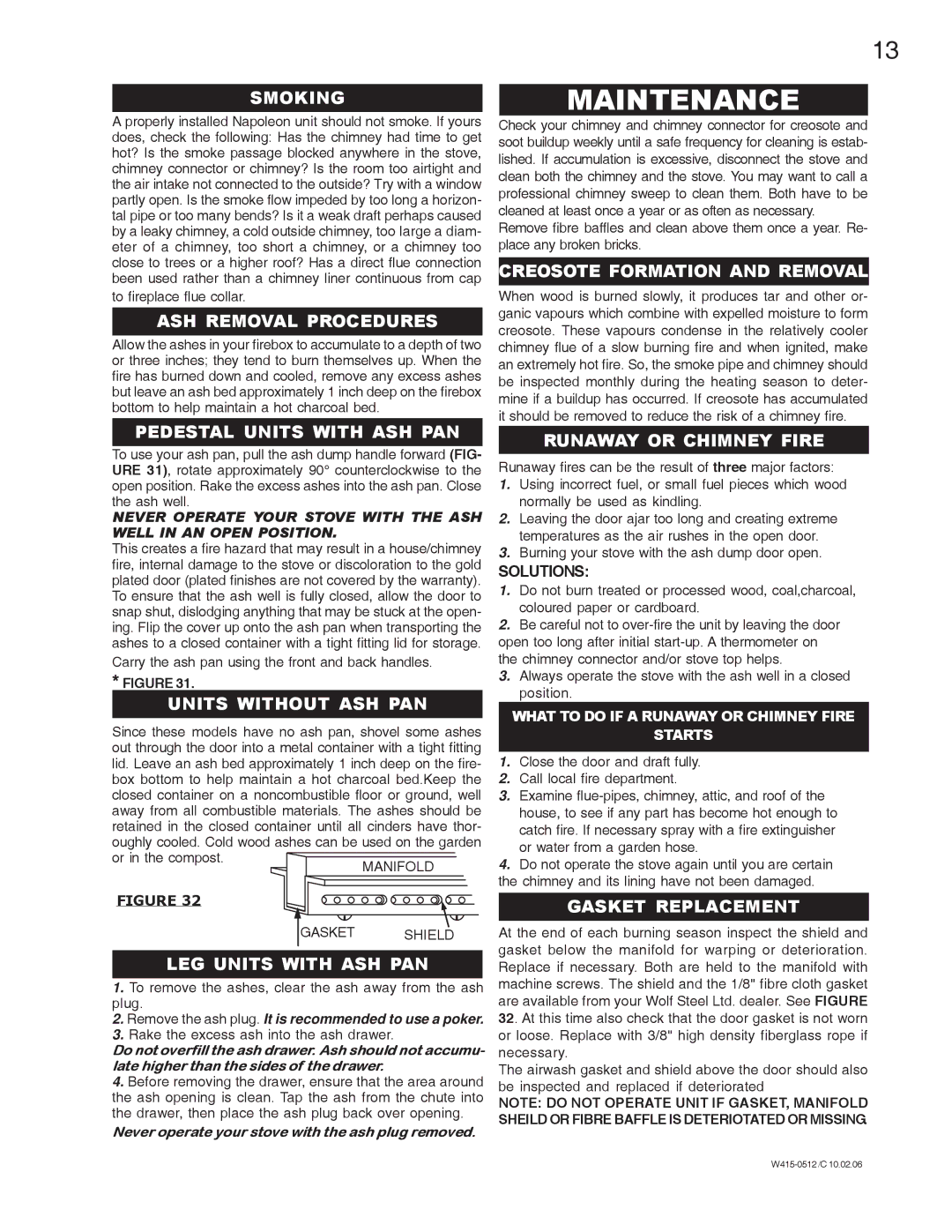SMOKING
A properly installed Napoleon unit should not smoke. If yours does, check the following: Has the chimney had time to get hot? Is the smoke passage blocked anywhere in the stove, chimney connector or chimney? Is the room too airtight and the air intake not connected to the outside? Try with a window partly open. Is the smoke flow impeded by too long a horizon- tal pipe or too many bends? Is it a weak draft perhaps caused by a leaky chimney, a cold outside chimney, too large a diam- eter of a chimney, too short a chimney, or a chimney too close to trees or a higher roof? Has a direct flue connection been used rather than a chimney liner continuous from cap
to fireplace flue collar.
ASH REMOVAL PROCEDURES
Allow the ashes in your firebox to accumulate to a depth of two or three inches; they tend to burn themselves up. When the fire has burned down and cooled, remove any excess ashes but leave an ash bed approximately 1 inch deep on the firebox bottom to help maintain a hot charcoal bed.
PEDESTAL UNITS WITH ASH PAN
To use your ash pan, pull the ash dump handle forward (FIG- URE 31), rotate approximately 90° counterclockwise to the open position. Rake the excess ashes into the ash pan. Close the ash well.
NEVER OPERATE YOUR STOVE WITH THE ASH WELL IN AN OPEN POSITION.
This creates a fire hazard that may result in a house/chimney fire, internal damage to the stove or discoloration to the gold plated door (plated finishes are not covered by the warranty). To ensure that the ash well is fully closed, allow the door to snap shut, dislodging anything that may be stuck at the open- ing. Flip the cover up onto the ash pan when transporting the ashes to a closed container with a tight fitting lid for storage.
Carry the ash pan using the front and back handles.
*FIGURE 31.
UNITS WITHOUT ASH PAN
Since these models have no ash pan, shovel some ashes out through the door into a metal container with a tight fitting lid. Leave an ash bed approximately 1 inch deep on the fire- box bottom to help maintain a hot charcoal bed.Keep the closed container on a noncombustible floor or ground, well away from all combustible materials. The ashes should be retained in the closed container until all cinders have thor-
oughly cooled. Cold wood ashes can be used on the garden |
or in the compost. | MANIFOLD |
|
FIGURE 32 | |
GASKET | SHIELD |
LEG UNITS WITH ASH PAN
1.To remove the ashes, clear the ash away from the ash plug.
2.Remove the ash plug. It is recommended to use a poker.
3.Rake the excess ash into the ash drawer.
Do not overfill the ash drawer. Ash should not accumu- late higher than the sides of the drawer.
4.Before removing the drawer, ensure that the area around the ash opening is clean. Tap the ash from the chute into the drawer, then place the ash plug back over opening.
Never operate your stove with the ash plug removed.
MAINTENANCE
Check your chimney and chimney connector for creosote and soot buildup weekly until a safe frequency for cleaning is estab- lished. If accumulation is excessive, disconnect the stove and clean both the chimney and the stove. You may want to call a professional chimney sweep to clean them. Both have to be cleaned at least once a year or as often as necessary.
Remove fibre baffles and clean above them once a year. Re- place any broken bricks.
CREOSOTE FORMATION AND REMOVAL
When wood is burned slowly, it produces tar and other or- ganic vapours which combine with expelled moisture to form creosote. These vapours condense in the relatively cooler chimney flue of a slow burning fire and when ignited, make an extremely hot fire. So, the smoke pipe and chimney should be inspected monthly during the heating season to deter- mine if a buildup has occurred. If creosote has accumulated it should be removed to reduce the risk of a chimney fire.
RUNAWAY OR CHIMNEY FIRE
Runaway fires can be the result of three major factors:
1.Using incorrect fuel, or small fuel pieces which wood normally be used as kindling.
2.Leaving the door ajar too long and creating extreme temperatures as the air rushes in the open door.
3.Burning your stove with the ash dump door open.
SOLUTIONS:
1.Do not burn treated or processed wood, coal,charcoal, coloured paper or cardboard.
2.Be careful not to over-fire the unit by leaving the door open too long after initial start-up. A thermometer on the chimney connector and/or stove top helps.
3.Always operate the stove with the ash well in a closed position.
WHAT TO DO IF A RUNAWAY OR CHIMNEY FIRE
STARTS
1.Close the door and draft fully.
2.Call local fire department.
3.Examine flue-pipes, chimney, attic, and roof of the house, to see if any part has become hot enough to catch fire. If necessary spray with a fire extinguisher or water from a garden hose.
4.Do not operate the stove again until you are certain the chimney and its lining have not been damaged.
GASKET REPLACEMENT
At the end of each burning season inspect the shield and gasket below the manifold for warping or deterioration. Replace if necessary. Both are held to the manifold with machine screws. The shield and the 1/8" fibre cloth gasket are available from your Wolf Steel Ltd. dealer. See FIGURE 32. At this time also check that the door gasket is not worn or loose. Replace with 3/8" high density fiberglass rope if necessary.
The airwash gasket and shield above the door should also be inspected and replaced if deteriorated
NOTE: DO NOT OPERATE UNIT IF GASKET, MANIFOLD SHEILD OR FIBRE BAFFLE IS DETERIOTATED OR MISSING.

